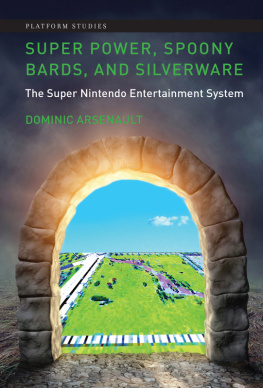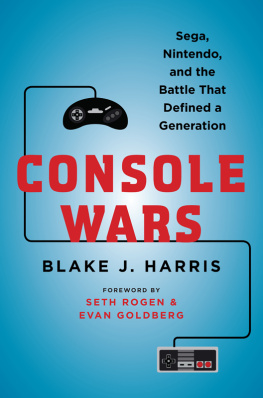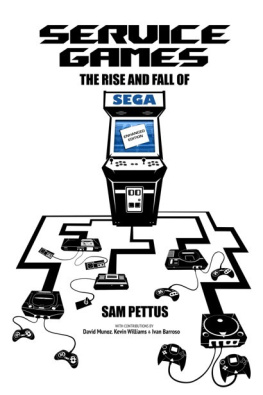
Playing at the Next Level
A History of American Sega Games
Ken Horowitz

McFarland & Company, Inc., Publishers
Jefferson, North Carolina
LIBRARY OF CONGRESS CATALOGUING DATA ARE AVAILABLE
BRITISH LIBRARY CATALOGUING DATA ARE AVAILABLE
e-ISBN: 978-1-4766-2557-7
2016 Ken Horowitz. All rights reserved
No part of this book may be reproduced or transmitted in any form or by any means, electronic or mechanical, including photocopying or recording, or by any information storage and retrieval system, without permission in writing from the publisher.
Front cover images 2016 iStock
McFarland & Company, Inc., Publishers
Box 611, Jefferson, North Carolina 28640
www.mcfarlandpub.com
To my loving wife and children. Without their support, I would never have found the strength to complete this immense task. They are my foundation and my future, and they fuel my creative fire and curiosity.
I must also dedicate it to my brother, Daniel, who was the prime catalyst in getting this whole ride started. He motivated me to pursue this project, and for that I am forever grateful.
And I salute the late Joe Miller, former senior vice president of product development for Sega of America, who died in 2014. He embodied everything that the product development group represented: creativity, innovation, and the true pursuit of the next level. He was a special person and will definitely be missed by all those who knew him.
Acknowledgments
There are so many people without whom this book would not have been possible. I would like to thank them all, even if I cannot do so individually. A select few stand out, however, in ways that simply must be openly acknowledged.
First, I would like to thank my wife, Iris, who for months would sit night after night and listen to me drone on about my latest interview and the history of Sega. Shes a real trooper, and any woman who would sit over coffee and listen to video game history for so long is definitely a keeper. Thank you, my little snowflake!
I would also like thank all the men and women who made Sega of America the magical place it was for almost two decades. Thanks to them, many video game fans were treated to some of the best entertainment ever to grace home consoles, and the profound impact they made is still felt today. It has been both an honor and privilege to tell their story, and I only wish I had enough pages to tell them all. There are also several former Sega alumni to whom I definitely need to give thanks. They took so much of their time to answer my emails and phone calls, check over drafts, procure images, and just otherwise ensure that the story of Sega of America was told as accurately as possible. Ken Balthaser, Michael Latham, Tony Van, Joey Berrios, Diane Fornasier, Tom Moon, Al Nilsen, and Mike WallisI salute you. You all truly bleed blue.
Preface
For more than a decade, Ive been interviewing programmers, producers, designers, and artists for www.sega-16.comanyone and everyone related to the inner workings of Sega. Ive made many contacts over that time and even a few friends, and the experience has been incredibly rewarding. Writing about Sega has allowed me to reach out to the people behind the magic curtain, the ones who made such a mark on my youth and adolescent years. Overwhelmingly, they have been friendly, cooperative, and even as excited as me about sharing Segas past.
I eventually felt that there was an overall history of Segas game-making that had not been told. Other books revealed many aspects of its culture and people, but the developers themselves were mostly kept to the second stage. My own fascination with Sega has always been with the behind-the-scenes events that produced so much great software, and I saw that this was a niche that had yet to be filled. Id long tossed around the idea of writing a Sega-related book, and I soon realized that the people who made my favorite games had not been given their due in history. I decided that this situation needed to change.
The games selected for this book are not necessarily chosen based on sales, which was indeed a factor, but mostly on the mark that was left on those of us who played them when they were first released. Im sure some readers may feel certain games were left out or that others should not have been included, and of course there is a certain level of subjectivity in all our lists of favorite games. It would have been impossible to include every title here, but those that are discussed should present a much clearer picture of what the game creation process at Sega and its teams was like back in the early to mid1990s.
With Playing at the Next Level, I strive to illustrate the storied history of Sega of America. I endeavor to show how the company grew from a handful of people operating out of a warehouse to one of the largest game development studios in the word, as well as its almost complete withdrawal from Western game development. Every in-house Sega studio is represented here, as well as some of the most influential and impactful games developed by third-party teams and released by Sega. Many of these stories have never been published before, and it has been my intention to provide as complete a view as possible into what were the golden years of Sega of America. There is no particular star character of the book. Everyone included here served a vital role in Segas rise to greatness. I only wish I could have included everyone.
Playing at the Next Level is arranged in chronological order, based on when a particular studio or company was formed or released the games discussed. It is important to keep in mind that there can be no strict timeline for discussion, as many of the events covered here occurred simultaneously. I feel it is better to organize the book according to developer than by game title, so as not to jump back and forth chronologically with each company. Think of each chapter as an individual neighborhood of a larger city, coexisting with others but with its own story and protagonists. Many of the developers mentioned here were involved with several aspects of Segas business or released multiple games, so they appear in multiple chapters. Their individual histories, however, will only be referenced with their earliest works.
Interviewing almost 100 people has often been a long and difficult process, but I think it is well worth the effort. I hope this book will enlighten readers to what it was that made Sega so special to its fans, and why we miss it so much today. It offers insight into all the challenges and problems those involved had to overcome in order to provide us with hours of enjoyment. May this book provide you with even a fraction of that joy.
The Return of the American Video Game Market
In any conversation about the 1980s, after everyone laughs about their Alf dolls and Rubiks Cubes, one item is sure to eventually find its way into the conversation. The Nintendo Entertainment System (NES) is forever tethered to that iconic decade of American history, thanks to a massive library of spectacular games, the iron-fisted control of retailers, and a little plumber named Mario. Most Americans tend to automatically associate Nintendo with video games, and understandably so. With over 30 million units sold in the United States alone, the NES could be found in a third of the nations homes by 1990 (Sheff 172). Thats a major accomplishment, considering that only a decade earlier, no one in the country knew what Nintendo was. At the start of the 80s, Atari was the biggest name in video gaming, and the home console industry was mostly American.
Next page










